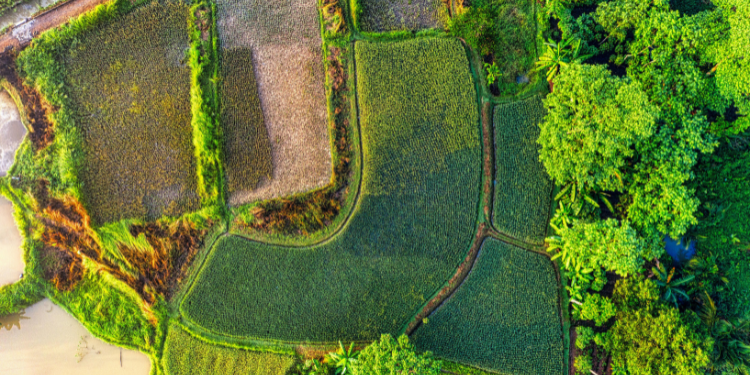CDSM
The proposed inversion model proposes an estimation of surface soil moisture by combining remote sensing data from Sentinel-1 and optical data from Sentinel-2 or Landsat. The proposed methodology is based on the change detection technique, applied to a series of measurements over a long period. The output from this algorithm is a surface soil moisture (SSM) index ranging between 0 and 1, with 0 corresponding to the driest soils and 1 to the wettest soil. This moisture index is converted on a volumetric soil moisture by knowing minimum and maximum of surface soil moisture temporal levels. Analysis is proposed for two vegetation classes in order to reduce effects due to vegetation on radar signal. The algorithm is proposed at agricultural field scale. It uses Google Earth Engine that allows to retrieve all radar and optical temporal series without loading satellite images.
The SSM is one of the main factors affecting the radar signal. To link between the radar backscattering and SSM values, a classical change detection index were used in (1-4) and defined as:

Where ![]() is the soil moisture content at time t;
is the soil moisture content at time t; ![]() and
and ![]() are the minimum and maximum values of SSM along the time series, respectively
are the minimum and maximum values of SSM along the time series, respectively ![]() is the radar signal at time t; and
is the radar signal at time t; and ![]() and
and ![]() are the minimum and maximum values of the radar signal time series, respectively. An index equal to 0 characterizes to the driest context at time t along the entire time series, and an index equal to 1 distinguishes to the wettest context. According to the aforementioned equations and by knowing
are the minimum and maximum values of the radar signal time series, respectively. An index equal to 0 characterizes to the driest context at time t along the entire time series, and an index equal to 1 distinguishes to the wettest context. According to the aforementioned equations and by knowing ![]() and
and ![]() values and radar signal, we can estimate the
values and radar signal, we can estimate the ![]() based on the following expression:
based on the following expression:

Additionally, the radar signal is influenced by the vegetation presence. To ingest this impact, we calculated the change detection index according to two classes of NDVI:

No datacube available for this model.
CDSM: Change Detection Algorithm for Soil Moisture Estimation
θ: Incidence angle
NDVI: Normalized Difference Vegetation Index
NDVI_min: Temporal minimum of NDVI
NDVI_max: Temporal maximum of NDVI
SAR: Synthetic Aperture Radar
SSM: Surface Soil Moisture
SSM_min: Temporal minimum of Surface Soil Moisture
SSM_max: Temporal maximum of Surface Soil Moisture
VV: Vertical-Vertical polarization radar signal
σ^0: Radar backscattering coefficient
σ_(VV,min)^0: Temporal minimum of VV radar backscattering coefficient
σ_(VV,max)^0: Temporal maximum of VV radar backscattering coefficient
S-1: Sentinel-1
S-2: Sentinel-2
L-8: Landsat8
(1) Foucras M., Zribi M., Albergel C., Baghdadi N., Calvet J.C., Pellarin T., Estimating 500-m Resolution Soil Moisture Using Sentinel-1 and Optical Data Synergy, Waters, 12 (3), 866, 2020.
(2) Nativel, S.; Ayari, E.; Rodriguez-Fernandez, N.; Baghdadi, N.; Madelon, R.; Albergel, C.; Zribi, M. Hybrid Methodology Using Sentinel-1/Sentinel-2 for Soil Moisture Estimation. Remote Sens. 2022, 14, 2434. DOI: 10.3390/rs14102434. (
3) Zribi, M., Chahbi, A., Lili, Z., Duchemin, B., Baghdadi, N., Amri, R., Chehbouni, A., 2011, Soil surface moisture estimation over a semi-arid region using ENVISAT ASAR radar data for soil evaporation evaluation, Hydrol. Earth Syst. Sci, 15, 345-358.
(4) Zribi M., Foucras M., Baghdadi N., Demarty J. and Muddu S., A New Reflectivity Index for the Retrieval of Surface Soil Moisture From Radar Data, in IEEE Journal of Selected Topics in Applied Earth Observations and Remote Sensing, vol. 14, pp. 818-826, 2021, DOI: 10.1109/JSTARS.2020.3033132
